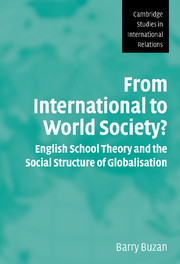 From International to World Society?
From International to World Society? Published online by Cambridge University Press: 14 January 2010
In chapter 1 I set out both my dissatisfactions with English school theory, and the reasons why I nevertheless thought it well worth pursuing. I committed myself to trying to shine some light on the important, but murky, relationship between international and world society, and to developing a structural interpretation of English school ideas, constructing them as a theory about norms rather than a normative theory. I also committed myself to using the methodological pluralism of English school theory, and its ability to look at several things at once, as a way of unpacking the problem of globalisation, and gaining more leverage on it. This agenda took me much deeper than I had originally intended, and with some help from various thinkers both inside and outside the English school, I have ended up with a rather radical revision of the classical three traditions. I hope I have also ended up with a plausible way of looking at the complex package of things that constitute the globalisation problematique.
Since misunderstandings seem to occur with frightening ease in academic debates, let me state very clearly for the record that I do not intend that this structural rewriting of English school theory should replace or override the normative version of English school thinking which I labelled Wightian in chapter 1. Wight's three traditions of debate about international relations, and the ongoing tensions between a prevailing orthodoxy and the various visions that challenge it, remains a valid and necessary understanding of English school theory.
To save this book to your Kindle, first ensure [email protected] is added to your Approved Personal Document E-mail List under your Personal Document Settings on the Manage Your Content and Devices page of your Amazon account. Then enter the ‘name’ part of your Kindle email address below. Find out more about saving to your Kindle.
Note you can select to save to either the @free.kindle.com or @kindle.com variations. ‘@free.kindle.com’ emails are free but can only be saved to your device when it is connected to wi-fi. ‘@kindle.com’ emails can be delivered even when you are not connected to wi-fi, but note that service fees apply.
Find out more about the Kindle Personal Document Service.
To save content items to your account, please confirm that you agree to abide by our usage policies. If this is the first time you use this feature, you will be asked to authorise Cambridge Core to connect with your account. Find out more about saving content to Dropbox.
To save content items to your account, please confirm that you agree to abide by our usage policies. If this is the first time you use this feature, you will be asked to authorise Cambridge Core to connect with your account. Find out more about saving content to Google Drive.